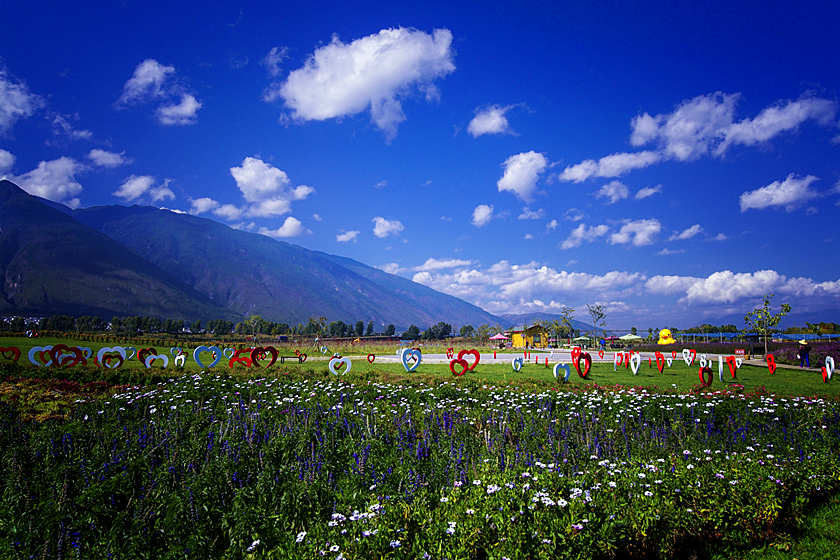Chinese Name: 苍山 Pronunciation: Cāngshān
Recommended Time for Visit: 3-4 Hours
Height: 4,122 meters (1,3523.62 feet)
Area: 23.5 square kilometers
Admission Ticket Fare: 40 yuan (Children under 1.2m tall are free of charge)
Address: Cangshan scenic spot, West Yinxian Road, Dali ancient city, Dali Bai Autonomous Prefecture, Yunnan Province
Best Travel Time: Cangshan Mountain is worth visiting all the year round. And Autumn(September to November) is the best time to travel. At that time, people have the opportunity to have a look of the beautiful scenery of azaleas.
|
Contents
|
Price
|
|
| Round-way Cableway Ticke | One-way Cableway Ticket | |
| Gantong Cableway | 110 yuan | 85 yuan |
| Xima Pool Cableway | 290 yuan | 195 yuan |
| Zhonghe Cableway | 105 yuan | 70 yuan |
| Note: Half-price ticket for children between 1.2 and 1.4m (3.9 - 4.6 feet) Free for children under 1.2m |
||
|
Low Season
(November 16th ~ March 31st) |
Peak Season
(April 1st ~ November 15th) |
|
| 8:30-15:40 | 8:30-16:10 | |
Cangshan Mountain is a world-class Geopark. As the main peak of the southern end of Yunling mountain, Cangshan Mountain consists of 19 peaks from north to south, ranging from Dengchuan Town, Eryuan County in the north to the Tiansheng Bridge, Xiaguan in the south. The average height of these 19 peaks is about 3.5 kilometers above sea level. The towering Cangshan Mountain is in marked contrast with the peaceful Erhai.
As one of the most famous four features (wind, flower, snow, moonlight) in Dali, “Cangshan snow” is famous for its beautiful environment and majestic snow scenery on the main peak. In the middle of the Cangshan Mountain, there is a long mountain trail(18km) named Jade Belt Cloud Travel Road, overlooking Dali dam and Erhai.
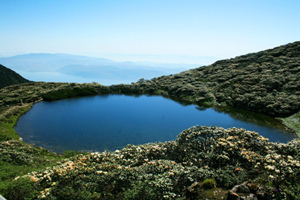
Xima means cleaning a horse in Chinese. It is said that the troops led by Kublai khan, the fifth emperor of the Yuan Dynasty, have stationed in Cangshan Mountain and cleaned their horses in the pool, hence it was named as Xima Pool.
Located at the junction of Yuju Peak and Longquan Peak, Xima Pool is 3,920m above the sea level and only about 20m (66 feet) from the top of Cangshan Mountain. Xima Pool is actually an artificial lake built in the Nanzhao Kingdom period with the depth of 1.5m.
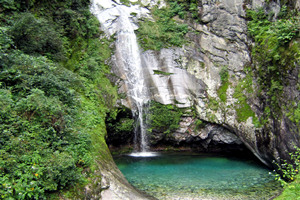
There are 18 streams in Cangshan Mountain, and the most beautiful one is Qingbi Stream. Located between Malong peak and Shengying peak of Cangshan Mountain, the water of Qingbi stream converges into three pools: upper, middle and lower on the hillside. And then it flows down into Erhai Lake. By virtue of its limpidness and tranquility, Qingbi Stream is doubtless a great place for travelling and sightseeing.
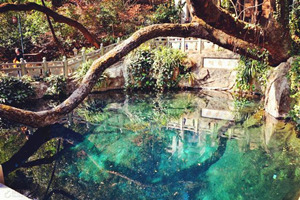
As the name suggests, Butterfly Spring is a spring where people can enjoy the wonderful scenery of butterflies. With thousands of butterflies around the spring, it looks like a fairyland. Located at the foot of Yunnong Peak, butterfly spring is about 40 km from Malong Peak, 25 kilometers away from the ancient city, 40 kilometers away from Xiaguan, and 25 kilometers away from the north of Dali ancient city. In Bai people’s minds, butterfly spring is a spring symbolizing love and loyalty. Every year, the young men and women from all walks of life come here to "throw a stone to test the depth of water" and look for their Mr. or Mrs. Right in songs.
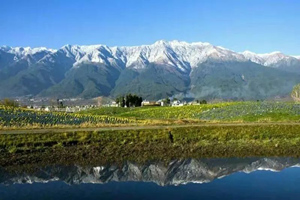
The 19 peaks in Cangshan Mountain are all above 35 kilometers above sea level. Due to the high altitude, it is extremely cold at the top of the peaks. Cangshan Mountain is covered with snow all year round, the snow of which looks like a dazzling crystal under the sunlight.
Cangshan Mountain Snow is the most beautiful of the Four Famous Scenes (wind, flowers, snow and moon) in Dali. And its beauty attracts a steady stream of visitors. Due to the high altitude and low temperature in the morning and evening at the top of Cangshan Mountain, it is recommended to take sufficient clothing when climbing up the mountain.
Demi-Gods and Semi-Devils Film and Television City, located in Dali Bai Autonomous Prefecture, Dali City, Yunnhan Province, was constructed in 2002, covering an area of 510,000 square meters, with a total construction area of about 25,000 square meters. In consideration of its natural terrain, the stepped distribution of the buildings of Demi-Gods and Semi-Devils Film and Television City is adopted. Demi-Gods and Semi-Devils Film and Television City is mainly composed of 146 single buildings with masonry and timber structure as its main body and with green bricks and tiles as its main building materials. It is a comprehensive tourist area with the functions of sightseeing, cultural entertainment, leisure and vacation.
In May 2002, selected as the shooting location of the TV series Demi-Gods and Semi-Devils, the construction of Demi-Gods and Semi-Devils Film and Television City started. On December 1 of the same year, the crew of the TV series Demi-Gods and Semi-Devils started their shoot in this film and television city. On January 31, 2003, the TV series Demi-Gods and Semi-Devils was completed, and on December 11 of the same year, the TV series was premiered on Zhejiang Satellite TV.
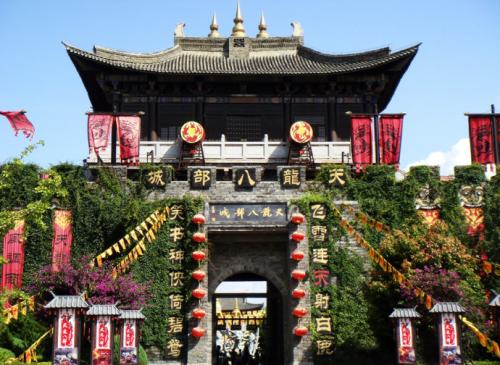
In addition to Demi-Gods and Semi-Devils, many films and TV series have been shot in Demi-Gods and Semi-Devils Film and Television City, such as Tea-horse Ancient Road, Legend of Yin Shang Dynasty, Dali Princess, Almost Perfect etc.
This film and television city is composed of three areas, including Kingdom of Dali, the Liao Dynasty, Palace of the Western Xia Regime and Jurchen Tribe etc. attractions.
In the Kingdom of Dali, there are Dali Street and Palace of Southern Town. Palace of Southern Town, located in the middle of Dali Demi-Gods and Semi-Devils Film and Television City, was built according to the description of “Palace of Southern Town” in the original work of Demi-Gods and Semi-Devils which is written by Jin Yong (the famous writer Louis Cha). The palace is composed of many parts, including the gate, vestibule, chamber, lodgings, back garden, flower hall and Sutra Pavilion.
In the area of the Liao Dynasty, there are Liao city gate and Liao streets in different scales. The palace of the Western Xia Regime, commonly known as the Imperial Palace, is located in the southern end of Dali Demi-Gods and Semi-Devils Film and Television City. The building of the palace imitates the style of the imperial palace of the Song Dynasty(960-1279) and integrates the characteristics of Dali city and Buddhist culture. The front yard of the palace is the main hall, and the back yard is the study and bedroom hall.
There are many scenic spots in the film and television city, like Zhenlong Chess Formation and The Four Monk Pagoda and so on. Located in the central part of Dali Demi-Gods and Semi-Devils Film and Television City, Zhenlong Chess Formation is constructed based on the description of “Zhenlong Chess Game” in the Jin Yong’s novel of Demi-Gods and Semi-Devils. And about the Four Monk Pagoda, located in the northeast of Demi-Gods and Semi-Devils Film and Television City, it is a stone Buddhist pagoda in which were buried four Japanese monks who passed away in Dali during the Hongwu Period(1368-1398) of the Ming Dynasty.
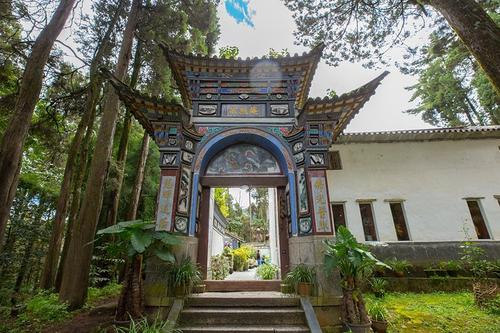
Jizhao temple (means tranquility and illumination) is located at the south foot of Shengying peak of Cangshan Mountain in Dali. The temple is surrounded by flourishing green pines and ancient cypresses and wrapped by smog. The temple is hugged by tranquility and elegance and is regarded as a pure place for Buddhists.
Jizhao temple gets its name from a Chinese verse, that is “feeling and then understanding, tranquility, reflecting”. The temple was originally built in the early Ming Dynasty(1368-1644) and then destroyed for some unknown reasons, and then the temple was reconstructed under the auspices of Tang Jiyao, the main leader of Chongjiu revolution in Yunnan. The three Chinese characters on the gate of the temple are the inscription of Tang Jiyao. With freshness and elegance filling the temple, it interprets the real poetic and picturesque splendor of life.
In the impression of most people, most of the temples are built in magnificent glow and are never lack of joss sticks and candles burning in temple. Surprisingly, Jizhao temple is just the opposite. With simple construction and compact layout, the temple presents a unique feature. Different from temples in other place, Jizhao temple don’t allow tourists to burn joss sticks and candles. Well known for its beautiful sight of succulents all around, the temple has attracted a lot of tourist every year. The temple enjoys great popularity in Yunnan by virtue of attractive and lovely flowers and plants. Stepping into the threshold of the temple, you will see all kinds of flowers and plants on both sides. You’ll marvel at the fascinating character which is different from other temples. The temple is more like a fine-looking garden full of vigor than a temple used only for worshiping the Buddha. Only when people stood in the temple, could people realize what it is--A winding path leads to secluded place, a meditation chamber deep in the flowering trees!
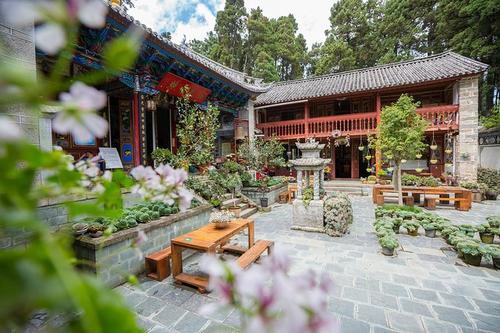
Jizhao temple offers Vegetarian food which can purify the tourist’s heart and limit their desire. Many people come here in admiration for this kind of food. Jizhao Temple charges 20 yuan per person. The vegetarian food offered here is free during the first and the fifth day of lunar month as well as every weekend.
Jizhao temple, famous nunnery, is also known as the most beautiful nunnery. Unlike other temples, Jizhao temple has no smoke and incense altar. There are only a lot of plants here. The abbess of this temple is master Miaohui. Master Miaohui came to Gantong temple at the age of 8. She recites and chants scriptures as well as crayoning Buddhist statues with other nuns since the restoration of the temple in 1982. In 1989, she became the abbess of Jizhao nunnery. Master Miaohui has spent more than 40 years in the temple.
Despite the fact that Master Miaohui has lived here for more than 40 years, she has developed her own unique insights on Buddha and beauty. She decorates Jizhao nunnery into the most attractive temple in Dali. There are two greenhouses behind the Jizhao nunnery where a lot of flowers and plants are planted in. One is mainly for planting succulents and the other is for planting flowers. Master Miaohui names it “Hundred-flower Garden”.
On May 23, 2017, attracted by the fascinating scenery of the temple, Han Hong, a famous singer in China, came to Dali to appreciate the extraordinary splendor of this most beautiful temple, and communicated with Master Miaohui.
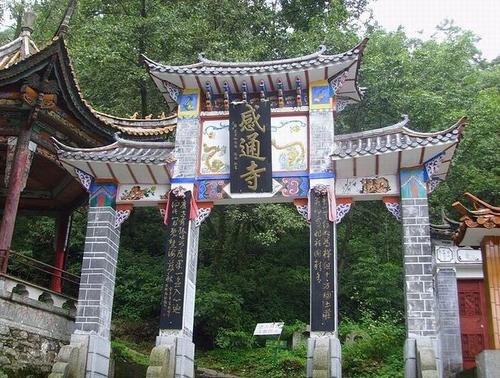
Gantong temple, also known as Dangshan temple, is located at the south foot of Shengying Peak of Cangshan Mountain, between Dali ancient city and Xiaguan, about 5 km away from Dali ancient city and 11 km away from Xiaguan. It is backed by Cangshan Mountain, which is covered with snow all the year round. There is a legend about the temple,which is, in the 17th year of Hongwu reign of the Ming Dynasty, master Wuji, the abbot of the temple, went to Nanjing to pay a pilgrimage to Zhu Yuanzhang, the emperor of the Ming Dynasty, and brought him a white horse and a tea tree. When he entered the hall, the horse hissed and flowers are in full blossom, which was regarded as an auspicious omen of the bright future of the Ming Dynasty.
Then, master Wuji was entitled “Fatian”, an honorific title in ancient times, and appointed as the great monk who was in charge of the temple affairs. What’s more, the emperor awarded master Wuji 18 poems. From then on, the Gantong temple became more prosperous. Gantong temple was built in the Han Dynasty and renamed as the Qiannian temple (means ‘a thousand years old temple’) in the Tang Dynasty(618-907). One of the special local products of Gantong temple is Gantong tea. After tasting it personally, Xu Xiake praised it as “the tea of great taste”. Nowadays, the Gantong temple has developed into a large-scale tea-planting base, and its tea has become the leading export tea in Dali.
Gantong temple is also known as “the first famous mountain of Cangshan and Erhai”. On the walls of the temple, there are a lot of philosophy Zen paintings and some Zen poems, from which you will have a perception about the temperament and wit of the master. From Gantong temple to Qingbi stream, a totally closed, safe and reliable ropeway with a total length of 2,630 meters has been built, which has become a beautiful landscape of Cangshan Mountain.
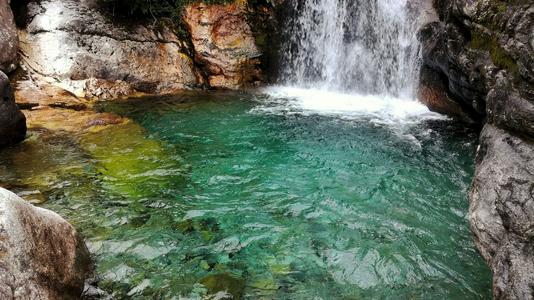
One of the attractive scenic spots in Cangshan is Qilongnv Pond (seven ponds). Qilongnv Pond is the first scenic spot on Yudai Yunyou Road (a blue stone path), 4.5km away from Qingbi stream. The pond is located in the middle of Heilong River. Along Heilong stream, there are seven natural clear spring pools from the bottom to the top. The waterfalls on the west side of each pool plunge down, just like white gauze hanging on the wall, giving people a feeling of being illusory and mysterious. The water in the pool is very limpid, surrounded by green hills and white stones. The pool looks like a fairyland in the cave. The Qilongnv Pond is unique for its deep location.
Huadianba(a flowerbed)is a famous scenic spot in Dali, Yunnan Province. Huadianba, composed of large and small flowerbeds, is located between Yunnong Mountain and Cangniang Mountain. The flowerbed is the hanging garden of Dali in folklore and it cannot be reached by car directly. This flowerbed is renowned as a paradise for hikers. The flowerbed is one of the few areas in Cangshan Mountain that has not been officially exploited. There is no highway in the flowerbed. According to the private history compiled in Nanzhao state, the flowerbed was inhabited before Jin Dynasty. Later, the indigenous people here gradually moved to other places due to the outbreak of the war. As time goes on, the flowerbed was left uncultivated. Many of the flowers and trees left at that time have a history of over a thousand years.
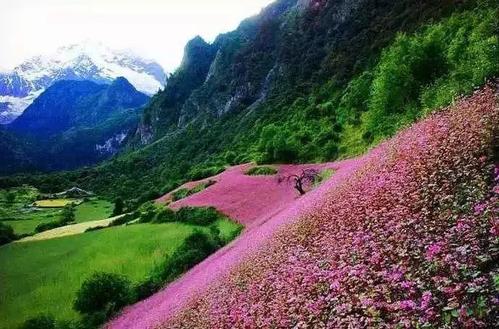
Huadianba is the kingdom of plants and flowers. The Rhododendron in the Royal Botanical Garden was transplanted from Huadianba. The Rhododendron was well-cultivated in British, and has been spread all over Europe. Dahuadian is about 2,900 meters above sea level, more than 10 kilometers long from north to south, and about 3 kilometers wide from east to west. The peaks on the west side of the flowerbed are covered with snow all the year round. The 40 streams, large and small, converge into Wanhua River which becomes the main water source in the flowerbed. The topography of Huadianba is flat. During the seasons of spring and summer, there are cherry blossoms all over the mountains and fields. The flower stretches for more than 10,000 meters, forming a sea of flowers. The white bean flower and peony flowers are mixed among the flowers. They are colorful and charming. Since the Ming and Qing Dynasties(1368-1912), scholars such as Li Yuan and Yang Shiyun have visited Huadianba successively and chanted poems which circulates for generations. In April and May in particular, Huadianba will become a world of flowers. This beautiful scenery of flowers has attracted many botanists at home and abroad to make scientific investigations. Safe and clean water as well as comfortable accommodations will be offered in the farms and villages near the flowerbed.
Hiking: Gantong Temple → Jizhao Temple → Qingbi Stream
There are mainly three different cableways which are convenient for tourist to get to Cangshan Mountain.
a. Xima Pool Cableway: Tianlongbabu film and television city → Qilongnu Pool→ Xima Pool
With the height of 1.6 kilometers and the length of 5.5 kilometers, Xima Pool cableway is the longest one and it consists of three stations: Upper- Lower Station, Middle- Lower Station and Upper- Middle Station. One can end one’s journey in the middle station and continue the trip on foot.
b. Gantong Cableway: Jizhao Temple → Gantong Temple → Qingbi Stream → Cangshan Grand Canyon
By taking Gantong cableway, you can enjoy the majestic views of Cangshan snow and Erhai Lake.
c. Zhonghe Cableway: Zhonghe village
Zhonghe cableway is the earliest one in Cangshan Mountain.
Take bus No.4 and get off at the Gantong Temple Station and walk about 8 minutes along the mountain road, then you will arrive at the Gantong cableway.
Chinese: 请带我去苍山。English: Please take me to the Cangshan Mountain.
If you go to the Cangshan Mountain by taxi from Dali Ancient Town, it takes about 15 minutes(about 20 yuan).
